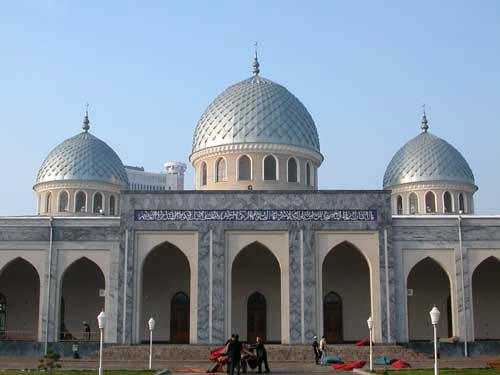Jami Mosque

Another name is Juma mosque, Friday mosque. The building is an architectural monument of the 14th-15th centuries; it is the third largest mosque in Uzbekistan after Bibi-Khanym (Samarkand) and Kalyan (Bukhara). The Juma mosque is the only example of a courtyard-type mosque in the capital.
The first building of the Tashkent Juma Mosque (Main Friday Mosque) was built in 1451 at the expense of Sheikh Ubaydullah Khoja Akhror (1404-1490).
Sheikh Ubaydullah Khoja Akhror was born in the village of Bogiston near the present Charvak reservoir. He was a great master of Sufism, leader of the Muslim clergy and a descendant of the Prophet Muhammad. One of the Sufi saints, Sheikh Affendi at-Takhur (Sheikhantaur), was his maternal relative. Ubaydullah Akhror, being very young, became the head of the Sufi order, founded by the followers of Bagautdin Naqshbandi. He significantly improved the philosophical and legal theory of the order, and by the middle of the 15th century. century became the leader of the Muslim clergy of the entire state inherited from Tamerlane. Ubaidullah Khoja Akhror had to leave Tashkent, since at that time the center of the clergy was Samarkand. In preparation for the move, he decided to build a mosque and madrasah as a gift to the residents of Tashkent.
In 1868, the mosque was destroyed by a strong earthquake, but in 1888 it was restored with funds from the Russian Tsar Alexander III. In connection with this event, the mosque began to be called the Royal Mosque. In 1997, the old mosque was demolished and a new one, the Jami Mosque, was built in its place. All that remains of the former mosque is the ancient layout and fragments of structures.
Sights of Tashkent
- Bolshoi Opera and Ballet Theater named after. Alisher Navoi
- Palace of Prince Romanov
- Abulkosim Sheikh Madrasah
- Kukeldash Madrasah
- Jami Mosque
- Monument "Courage"
- Museum of Applied Arts of Uzbekistan
- Monument to Alisher Navoi
- Amir Temur Square
- Bunyodkor Square - Friendship of Peoples
- Mustakillik Square
- Chorsu Market
- Tashkent TV tower
- Shahidlar Khotirasi - in memory of the victims of repression